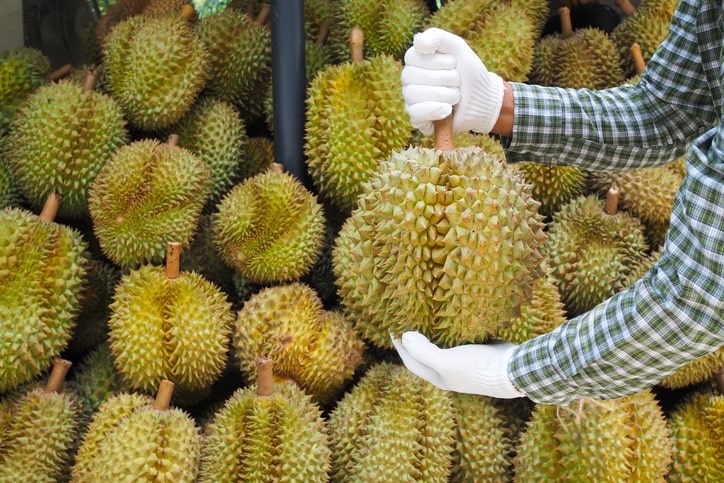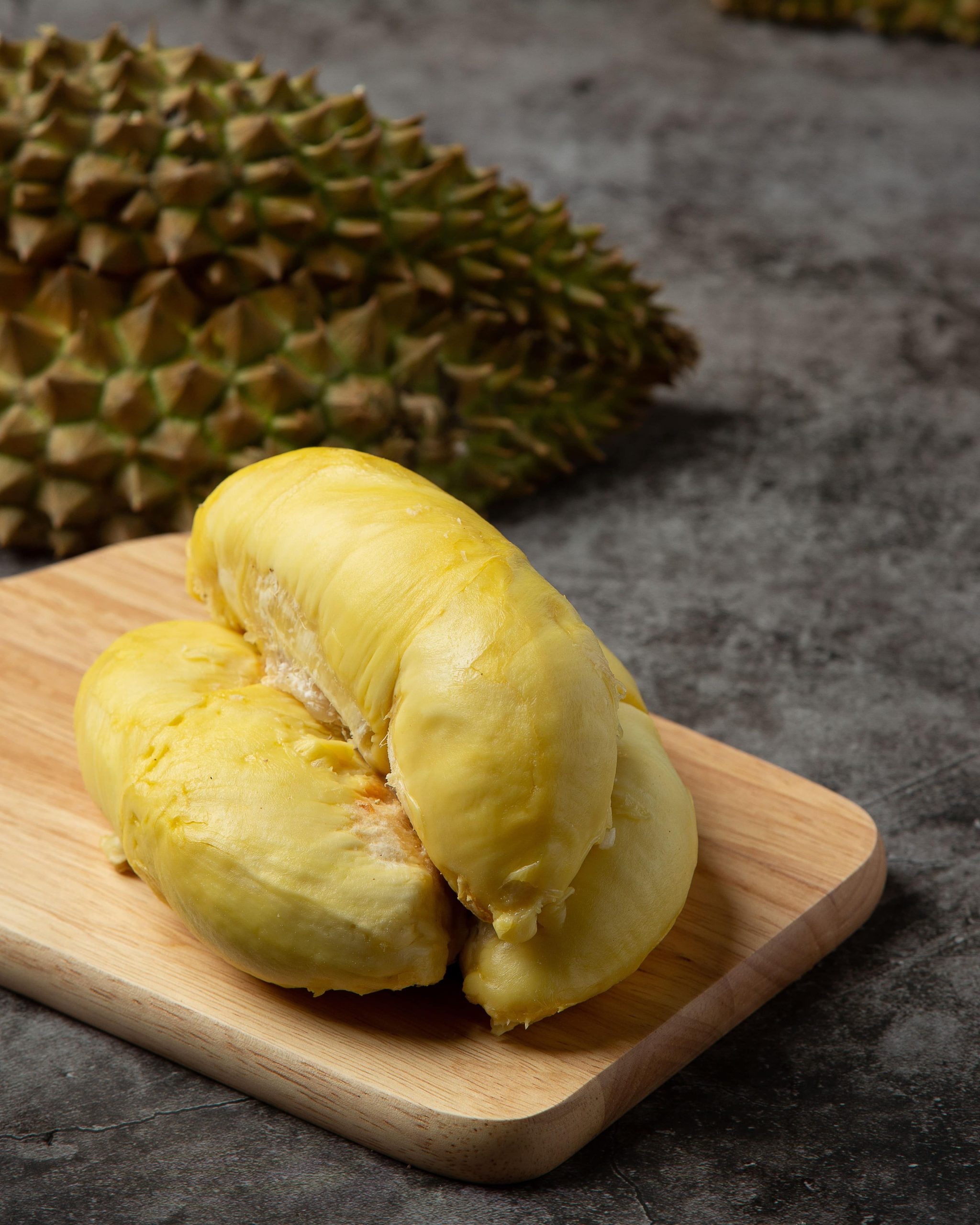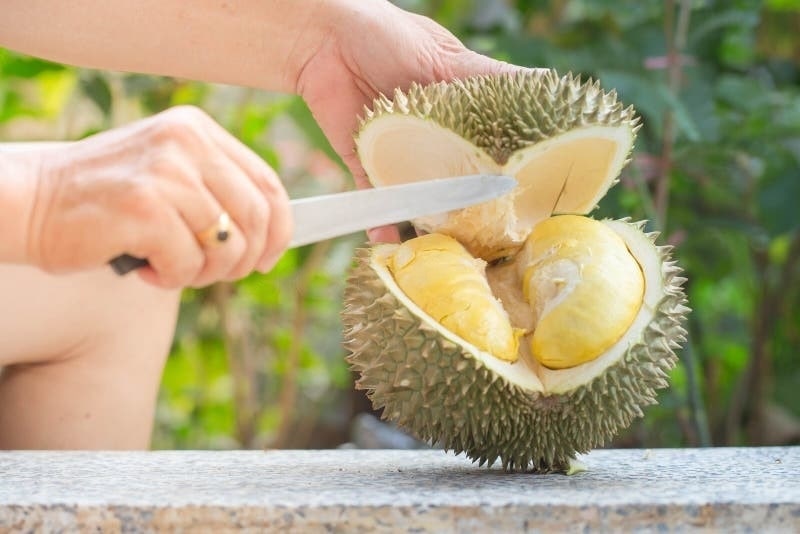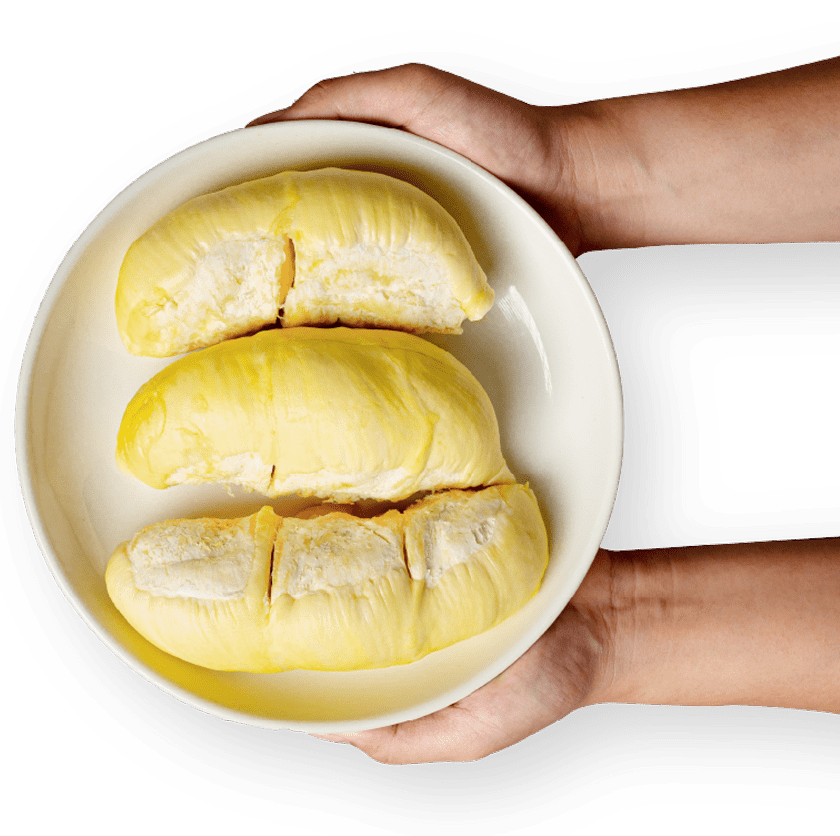30 Mar How to Choose A Good Durian: A Complete Guide

Tired of relying solely on what durian vendors tell you every time you buy durians?
Overwhelmed by the tons of online information when trying to learn how to choose a good durian?
Then this guide is for you!
In this guide, we’ve demystified the ways of selecting the perfect durian. Keep reading to discover more!
General Rules to Choose A Good Durian

Source: FoodNavigator Asia
To choose a good durian, consider the following tips:
1. Examine the Shell
Firstly, look at the condition of the spikes. The spikes on a durian should be firm and well-defined, not soft or withering.
If the spikes appear blunted, it may reveal that the durian has hit the ground. Such an impact can speed up the ripening process and affect its freshness.
Also, note that mature durians have pliable spike tips that can be pulled together more easily by fingers than those of immature fruit.
Next, inspect the shell for holes or black spots. The holes indicate that worms have entered the durian, while the black spots are the feces left behind by these worms. Both signs signify that the durian is no longer fresh.
It’s also crucial to check for cracks, especially at the bottom of the durian, as this is the most vulnerable area. Cracks suggest that the durian has been opened, exposing the flesh to potential contamination from the outer environment.
Regarding the color of the shell, green spikes with brown tips generally indicate perfect ripeness. A bright green shell may signify underripeness, while a brown or dull shell may suggest overripeness. However, light intensity can impact these colors.
2. Check the Stem
At first glance, a fresh durian should have a straight, rigid stem.
You can also gently scratch the stem to check its color. The color of a stem tells you how long the durian has fallen from the tree, providing an estimation of its freshness.
A greenish or slightly wet stem under the bark indicates extreme freshness, suggesting the durian was recently harvested. On the other hand, a dark stem suggests the durian was harvested earlier.
Notably, the color of the stem does not reveal the ripeness of the durian itself. Durians can sometimes fall off the tree before fully maturing due to heavy rain or strong wind.
3. Tap the Fruit
After examining the exterior condition of the durian, you can further assess its ripeness by tapping the fruit using a knife, wooden stick or even your fingertip.
A ripe fruit should produce a hollow sound when tapped, similar to hitting a drum, indicating the presence of air gaps inside the fruit.
If you hear a solid sound instead, the durian is still immature and not ready for consumption.
4. Shake the Fruit
If you don’t have any tools to tap the durians and prefer not to touch the spiky husk directly, hold the fruit close to your ear and give it one or two gentle shakes.
When shaken, a ripe durian should produce a clear, crisp yet slightly squishy sound. This indicates that the pulp has properly detached from the outer shell, which is a characteristic of optimal ripeness.
However, hearing a hollow sound or hard-knocking sound is more likely to indicate that the durian is underripe. On the contrary, if the durian is overripe, you’ll hear no sound at all.
5. Feel the Weight
Beyond visually inspecting a durian, the fruit’s weight can also offer valuable clues about its quality.
Good durians often weigh less than expected due to moisture loss. If the fruit feels lighter than anticipated, it’s typically a positive indication of ripeness—generally, durians weighing between 1.5 to 2 kg yield the best flavors.
On the other hand, it may be underripe if the durian is as heavy as expected or even heavier.
6. Check the Aroma
The aroma of a durian is often considered the ultimate litmus test for ripeness and quality.
A ripe, high-quality durian should emit a rich, pungent aroma that is unmistakably durian – a scent that some describe as a blend of creamy, sweet, and slightly savory notes that is not overpowering.
However, the durian is likely underripe if the aroma is faint or non-existent. Conversely, an overpowering, rotten smell could indicate an overripe or spoiled fruit.
When assessing aroma, sniff both ends of the durian (the upper part close to the stem and its bottom part). Since the pulps in the lobes ripen from the bottom up, the degree of ripeness can vary within the same fruit.
7. Inspect the Shape
The last aspect to consider when choosing a prime durian is its shape, as certain contours can signify desirable internal characteristics.
The table below shows the different shapes of durians and their respective general characteristics. However, these characteristics may vary according to different cultivars.
| Shapes of durian | Characteristics |
|---|---|
| 1. Circular or oval | • More pulps with thicker flesh • Durians with this shape are generally considered top-grade durians |
| 2. Lopsided or kidney-shaped | • Fewer pulps and less flesh • Can be more aromatic and creamier than perfectly rounded ones |
| 3.Bulging | • Bigger and fleshy pulps • Indicated by more sparsely arranged thorns due to thick pulps causing the husk to bulge |
| 4. Slightly flat area on the husk | • Lesser flesh with concentrated flavor |
By considering these factors, you’re equipped with the knowledge of how to choose a good durian for your enjoyment!
However, it’s undeniable that selecting a good whole durian by yourself can be quite time-consuming. That’s where buying from reliable sellers like Top Fruits comes in handy, saving you valuable time!
Top Fruits’ durian farm was awarded MyGAP (Malaysia Good Agriculture Practice) certification in 2013, showcasing Top Fruits’ commitment to stringent quality control in agricultural produce.
Visit our online store to find out more about our premium durians and durian-related products!
Taste of Different Durian Varieties

While the general tips we’ve covered will help you identify a prime, fresh durian, it’s also essential to understand the nuances between different varieties.
Malaysia is home to a diverse array of durian cultivars, each with its own unique flavor profile and characteristics. Your personal taste preferences will play a role in determining which variety is most appealing to you.
The taste chart of certain durian varieties below can aid you in making an informed decision on how to choose a good durian that perfectly suits your palate.
| Bitter | Sweet | Bitter + Sweet |
|---|---|---|
| • D198 Golden Phoenix | • D175 Red Prawn | • D197 Mao Shan Wang |
| • D24 XO (with alcoholic taste) | • D101 Red Flesh | • D13 Golden Bun |
| • Black Pear | • D163 Hor Lor | • D17 Lao Tai Po |
| • D160 Tekka | • D1 Ganghai | |
| • D200 Black Thorn | • D828 Meiqui | |
| • D88 Darling |
Preparing and Enjoying Durian Flesh

Once you’ve made your selection, the next step is to safely extract and savor that coveted creamy flesh.
To open a durian at home, you can follow these steps:
Step 1: Put on gloves or use a clean towel
- To protect your hands from the spikes and allow you to hold the durian steadily while cutting it.
Step 2: Cut off the stem
- Use a knife to slice the stem from the top of the fruit.
Step 3: Locate the seams
- The seam is the part where the shell of the durian comes together.
- By locating and cutting the seams, you can open the fruit easily.
- Sometimes, the seams of a ripe durian tear apart on their own, so you can pull the durian in half directly using brute force without cutting it.
Step 4: Cut along the seams
- Start with a shallow cut, then cut deeper progressively until the sections of the shell start coming apart.
Step 5: Pry the shell apart
- Once the cuts in the seam are deep enough, pick a seam and start opening the shell.
- Put your fingers on both sides of the seam opening.
- Pull the seams apart until the pulps inside are revealed.
As you master the art of opening a durian at home, you’re one step closer to indulging in the creamy goodness of this king of fruits!
However, opening a durian on your own can be quite troublesome. That’s where the convenience and versatility of packaged durian pulp and paste come in.
Top Fruits provides top-notch frozen durian seed pulp and frozen durian paste that preserves fresh durians’ authentic taste and delightful texture.
With these conveniently packaged products, you can enjoy durian pulps without a hassle and effortlessly incorporate the rich, creamy flavor of durian into your favorite recipes year-round!
Conclusion
By the end of this guide, you’ve been equipped with all the knowledge of how to choose a good durian and also the ways to prepare it for maximum enjoyment.
But don’t just limit yourself to durians! Expand your palate and indulge in the exquisite flavors of our other upstream products.
From fresh whole durians to an array of tropical delights like pineapple, cempedak, jackfruit, soursop, and mangosteen, there’s something to tantalize every taste bud.
Ready to take the next step? Contact us today, and let us help you discover the perfect durian and tropical treats for your culinary delights!
FAQ
What is the best season to buy durians in Malaysia?
The best season to buy durians in Malaysia is during the durian season, which typically spans from May or June through August or September, peaking in July and August. However, some varieties are available year-round, with slight variations in different states.
What is the ideal weight for a good durian?
The ideal weight for a good durian typically falls between 1.5 to 2 kg, as this range tends to yield the best flavors.
However, the weight can vary depending on the variety. Generally, a good durian should feel lighter than expected due to moisture loss, indicating ripeness.
Should I choose durians with cracks or holes in the husk?
No, it’s best to avoid durians with cracks, holes, or any damage to the husk, as these can be entry points for mold, insects, or premature germination, which can affect the flesh quality.
Is a stronger smell always better?
Not necessarily. While a strong aroma indicates ripeness, an overpowering or rotten smell can signify an over-ripe or spoiled durian. The ideal aroma should be rich and pungent but not unpleasant.
Can I choose a durian based on its color?
The color of the husk can provide some clues, but it’s not a definitive indicator of quality.
Generally, durians that have green spikes with brown tips indicate perfect ripeness. A bright green shell may signify underripeness, while a brown or dull shell may suggest overripeness.
What should I do if the durian vendor won’t let me sample it?
Reputable durian sellers in Malaysia typically encourage sampling before purchasing. If a vendor refuses, it may be a red flag, and it’s best to buy from a more reliable source.
Are more expensive durians always better?
Not necessarily. While price can sometimes indicate quality, it’s not a guarantee. Factors like variety, scarcity, and demand can also influence the cost. It’s essential to rely on your senses and knowledge to assess the durian’s quality.
Is it better to buy a larger durian instead of a smaller one for better taste?
Not necessarily. While some believe that larger durians contain more flesh and, therefore, more flavor, the taste is primarily influenced by ripeness, variety, and freshness.
Choosing a durian based on other factors like aroma and texture is more important.
Do consider the opinions of reputable sellers or durian experts when selecting a durian for the best taste experience.

